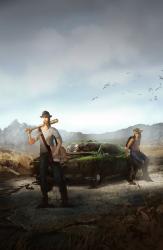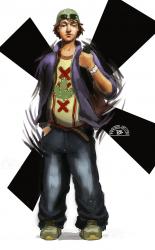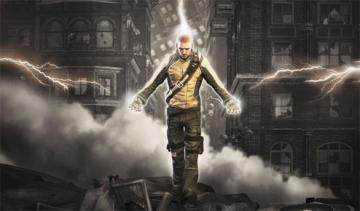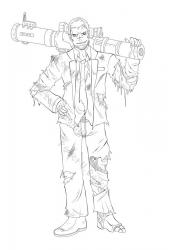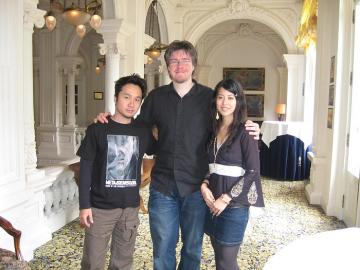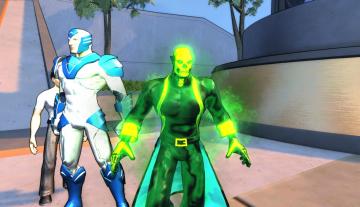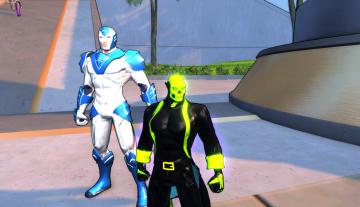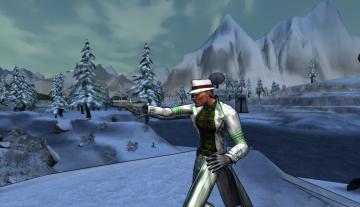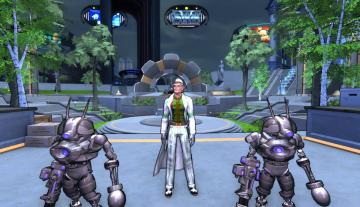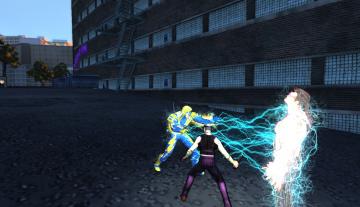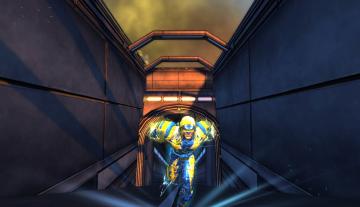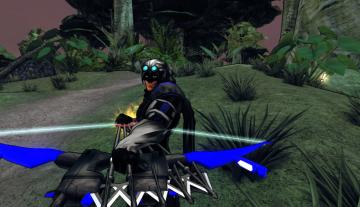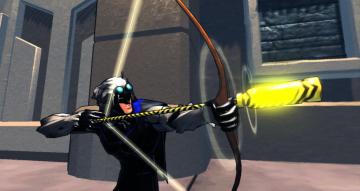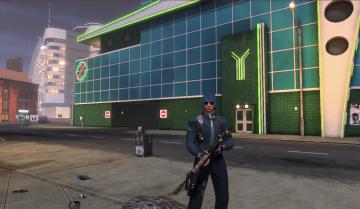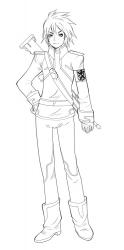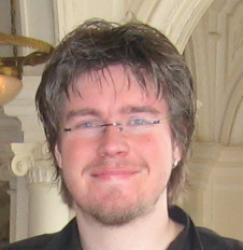
Peter
WebmasterEye For Games Interview: Tom Galt
zo 29 januari 2012 13:53:26A little while ago we managed to secure an interview with the lead designer for The Darkness II, Tom Galt. He spoke very openly about the challenges he faced during development, how he got to where he is now and what influenced the latest title created by his studio.
The original interview can be found on the Eye For Games website, here.
Please, tell us a little bit about yourself and how you got started in the industry.
Tom: "My name is Tom Galt, I’m lead-designer on The Darkness II at Digital Extremes. I’ve been in the industry for about ten years and I first started as basically an office lackey; making meeting notes, fixing computers, making sure the builds are working and that kind of stuff. I slowly worked my way into design departments, writing pitch documents, that kind of thing. Fixing collision and geometry in levels and eventually becoming a level designer and designer.
I was working at DICE Canada, the Canadian studio for Digital Illusions, where we worked on Battlefield 2: Special Forces, Battlefield: Vietnam, Battlefield 1942. There I was leading design teams on map packs and DLC stuff until EA bought DICE and closed DICE Canada. I wanted to stay in my hometown of London, Ontario, so I came over to work at Digital Extremes.
I’ve been here for about five years now, and yeah I’ve been working on The Darkness II for the last few years there. That’s me in a nutshell."
Did you ever think you wanted to follow this route, or was it a sudden decision?
Tom: "I never did. It’s funny; I’ve played games all my life, back from playing Donkey Kong at the arcades. I always thought that you needed math to make videogames because you needed to be a programmer. I didn’t know there were things like level designers and designers in videogames.
I’ve always loved science, so I got a degree in genetics and I got a master’s degree in biochemistry and was on my way to a PhD, making recombinant viruses to carry specific genes to study animal models of respiratory diseases and I kind of thought; “Wait a minute, what am I doing here?“
I knew a guy that worked at a game studio, so in a moment of clarity when I really thought about what I wanted to do with my life, I asked him if he could help me get a job. He did, so I dropped everything what I was doing and thought I’d give videogames a shot.
So yeah, I never had any specific training, besides playing a ton of games. I made my own Doom levels, Warcraft levels, that kind of thing and No, I didn’t think I’d work in this industry until I started working in the industry. I kind of leapt into it and I’m glad I did, I absolutely love it. It’s a great industry."
You’ve filled in a lot of functions in the past couple of years. Which one felt closer to your heart?
Tom: "I think being a lead designer is really what I love to do. Partially because I’m a control freak and I like to have my hand in the design and making sure that my input is being heard. I like design, particularly gameplay design. Level design I enjoy, but I’m not so good at it as some of the other designers hear, when it comes to envisioning spaces. I’m much better at sussing out mechanic design and the balance between system designs. So things like A.I., weapon design, mechanics and controls.
I was brought up on Mario and Zelda, so Miyamoto’s controls had a big influence on me from a young age. Controls and that kind of thing is really where I spent a lot of my time.
A game is all about mechanics, if you don’t have fun mechanics you’re not going to have a fun game. And on top of that, if you’re character isn’t easy to control and not responsive, you’re not going to have a fun game, no matter how good everything else is.
So back in the original days of Mario, how responsive he is, when you let go of the stick he stops and like how responsive the jump is, the charge jump that is something that I take to the games we make. Balancing the input for controlling the camera, balancing the weapons to make sure they all feel good and things like that, I spend a lot of time on that.
I think my true love there is being lead designer, being able to have my hands in all the different parts, especially in the direct controls and game balancing."
You mentioned level design being somewhat of a challenge for you, but did you have any other big or personal challenges during the time you spent in the industry so far?
Tom: "It’s harder for me personally to envision a space in my head and then develop that, whereas a lot of level designers I’ve worked with and now worked on The Darkness II with us are fantastic at visioning 3D spaces in their head, communicating that and then making it a reality. It’s not my strong suit.
Level design is a very tricky thing. It’s a very delicate balance between making good gameplay, good encounter spaces with a good flow, but also something that looks realistic, is immersive and is beautiful.
It’s easy to make a fun combat set-up in a box that’s ugly, but it’s a much different thing to make a fun gameplay space in a realistic environment. When you’re looking at making in New York Okay, so let’s make a level in the New York City streets for example. How are you going to block the streets off? You don’t want the player to run into an invisible wall, and you can’t block it off using a brick wall. You have to find creative ways to do that, creative ways to flow the levels through the city streets, then make sure they’re not going through the same street all the time. You have to make sure you’re leading the player with mixed distance and interesting things on the horizon.
There are a lot of elements that enter play to creating a good level that a lot of level designers are extremely talented at, so I guide them and make sure the gameplay is solid and that it’s going to hit all the beats that we use in the gameplay and the story. I rely on our team to use their expertise to create some of the beautiful levels you see in the game."
For The Darkness II, what kind of processes did you use when creating the gameplay, maybe some sort of special technique?
Tom: "Well, that’s an open-ended question, but I’ll try to clear it.
I think, first off, the quad wielding is obviously core to the game, it’s been in all of the marketing material and promotional aspects so far, and that drove a lot of our design and decision making. We came up with the quad wielding quite early in development, where we wanted to bring the demon arms to the forefront. They were cool in The Darkness 1; we thought they were pretty awesome, so we wanted to make them mainstays in the second game.
Once we made the slashing and the grabbing always there, that really formed what the game played like, because we had this cool mechanic. So that means the engagement distances with the enemies had to be really tight, we can’t have the player always shooting thirty to forty meters down the road. They need to be encouraged to run up to enemies, to get to within five to six meters of them and hit them with the slashing arm, or to grab the enemies themselves.
This was a really interesting departure for us, because there are not a lot of games out there we can use as reference points. It was really counter to a lot of what we’re used to in games, so it went against our instincts in creating levels. Where usually you have a fairly wide combat space, now it had to be quite tight and players had to be able engage enemies very quickly.
The process there was a lot of iteration of top-down map designs where we’d sort of spec out the basics of the level with the designers and the artists and then we would very quickly block it out and start putting in combat. We’d iterate on that for quite a while until we were happy with the engagement distances and the spaces and how the player could move through combat, how the enemies were spawning and how all that was working.
So there was a long period of discovery that lasted quite a while as we developed the quad wielding and figures out the engagement distances; how long can the slashing arc be? How far away should you be able to grab enemies from?
As we narrowed in on that, where we were developing combat encounters and that kind of thing and basically just iterating on both of them for a while until we were happy with it.
In a nutshell, the process was lots and lots of iteration on the encounters and prior to that lots and lots of iterations on the core mechanics to get something that was fun."
You talked about that there weren’t many games to take a look at when developing the core mechanics, but did the first game influence a lot or have you made a lot of different choices when compared to the first title?
Tom: "I think that the first game was a huge influence, but I’d say it was more aimed at the characters and story and the overall vibe in terms of the kind of story we’re telling. Gameplay wise we wanted to take it somewhere new. We didn’t want to do the sort of open world The Darkness 1 did. We felt we could tell a better story, something more engaging, if we had a more linear experience. So we had to take that into account when looking at the mechanics and how to update the gameplay from the first game to the second game.
We looked at the first game mechanics, all the powers, the controls and what we wanted to carry on into the second game. We were also looking at forums, what did players like, what did they not like? What powers do they think were cool? We tried to take that and use it to sort of guide our decisions.
In terms of the actual gameplay, we wanted to strike out on our own, but we did want to make sure that there were some good solid ties to the first game in terms of the powers Jackie has at his disposal."
You’ve worked on Bioshock 2 before, did your experiences on that game influence decisions made on The Darkness II?
Tom: "It did, actually. It’s interesting you say that. One of the interesting challenges with making a First Person Shooter where the player has more than just guns is making sure that whatever that plus one is, is that it’s useful. I mean, guns are extremely effective. If you have a good First Person Shooter, you got to have big guns, right?
So, if I have a gun in my hand, why not shoot the guy in the head when he’s five meters away? Why would I need to use my other abilities? You have to make sure that whatever else you have, that it complements the guns, without overshadowing them or without them being overshadowed by the guns.
Bioshock was a great example where you have your Plasmids. Sure, the player has guns there, but they also have all those Plasmids they can use. All these great abilities, like fire and ice and everything else. That was a great touchstone for how to combine all these abilities.
They took a slightly different approach in Bioshock, where the damage model is a little bit different. Enemies can take a lot more bullets in Bioshock than in The Darkness II and that’s where the Plasmids came in handy, to complement the damage you’re doing with your guns or to slow enemies down, that kind of thing.
It was a great lesson for us in different ways you can do that. We took that to heart and tried to do a little bit more in using enemy types as well to encourage combinations of powers and guns and then also looking at Darkness powers that could be Darkness powers but also affect guns as well. You’ll see that in things like Gun Channeling.
Another great example would be in the swarm power. We have a Darkness power here that you can use to pull anyone out of cover or hold him still for a second and that works great with grabbing or slashing, but it also works well with the guns, because you can pull him out and shoot him. That was our mandate from day one; making sure that the power complements the gunplay. So that players could play through anyway they want and if they wanted to use a gun, that’s great, but there are powers that can help them do that."
So what was it like working with an IP like this, considering you have a huge fan base coming from the comics that also play games? What’s the most difficult thing to cross your path?
Tom: "One aspect that was probably extremely difficult, but also made it fun and a little bit easier, was that the Darkness can do almost anything. If you read through the comic books it’s amazing what they have Jackie do. There’s this moment where he sinks the entire U.S. Pacific fleet, he’s extremely powerful!
Somewhere he’s underground, trying to rescue a friend and he actually travels through the earth to get back to the surface, because the earth is in darkness so he travels through it.
So that opened our eyes like; wow, we can do almost anything we want to and get away with it. That was liberating, but at the same time scary as hell. How do you balance this kind of thing, right? It’s both a blessing and a curse and that’s where things like swarming, gun channeling and the black hole come from. Like, what would really be awesome and cool, yet still work with the gunplay and still be something we can balance?
So that was a blessing and a curse in terms of looking at the comic books as a reference.
The other thing, I think was a boon, was that the characters are quite well defined in the comic book. Paul Jenkins, Marc Silvestri and the rest of the creators at Top Cow did an amazing job in fleshing out the characters and their motivations. You have Jackie, the hitman playboy who suddenly can’t have sex with women because he might die. So there are some funny internal struggles there that help define the character, the kind of people they are. That really helped form us in our decision making, creating our narratives.
We brought Paul Jenkins in to help us pick these things out and go over the comments and form the narrative, help us write interesting characters and dialog. "
Were there any ups and or downs when developing the game? What were the biggest negative or positive features to work with?
Tom: "Oh, I’ll think about it for a bit, but the first that comes to mind is the art-style. The graphic noir-style is absolutely beautiful and the end result is incredible. The art-team did a fantastic job. It took us quite a while to get there, quite a few months and a lot of iterations to get at that final look. That was quite a trying time during development, very difficult to work against deadlines when still trying to figure out our visual styles, but the end result has been extremely rewarding and all the pain and suffering we went through was absolutely worth it.
I think the art-style that we have suits the game and what it is extremely well and it also helps differentiate it from a lot of different games out there. It’s a really beautiful feature there.
Other challenges, you know It’s hard looking back sometimes.
One of the big challenges too was doing the balance and coming up with powers and abilities that would work well for Jackie, for this game. The demon ones were actually relatively easy to come up with, once we had an idea that fell into place quite quickly, but coming up with other powers and abilities that were balanced with guns and demon arms was quite challenging."
Now that the game is finished, or very close to being finished, could there be things you would like to or do differently in the future? Possibly for a third The Darkness game?
Tom: "Oh, absolutely! I have a long list of mechanics that we didn’t quite had time to get right, that I would love to take another shot at. There were some decisions in The Darkness II that I would like to look at again and try and reevaluate. Lots of powers that we had ideas for that we just weren’t able to fit in.
I think that any developer you talk to there’s always a list of things that, you know has a, “coulda, shoulda, woulda“ kinda thing to it.
Nothing in particular right now, but yeah, you’re always trying to look at things differently, trying to take it to the next level."
One of the major decisions was, as you mentioned earlier, the art style for the game. What was the ultimate reason to go for the cel-shaded style we see right now? Did you think it would fit the comics more?
Tom: "This was purely an artistic decision that the creative director and the art director made and it was that; we thought that going with the graphic noir art-style would make it really bring the comic book to life. We wanted to go back to the roots and embrace what The Darkness was and first and foremost it was a comic book. We thought it would be great to make it really feel like you’re playing a graphic novel. That’s really where our art-style came from.
Kudos to Sheldon [Carter], our creative director, and Matt [Tremblay], our art director, because the art-style really fits the action and it balanced the game really well.
It’s one thing to have a completely realistic game and ripping someone’s spine out there, than it is to have this graphic noir look and doing the same thing. It’s harder to sell when it’s realistic and it also has different undertones.
When you’re doing it in this sort of comic-book setting, it’s a bit more fitting, and a bit less gruesome. I think it fits really well."
With Eye For Games we focus on the fun of creating games, so here’s a question to get your own creative juices flowing. If you get the chance to work on a completely new title, in any genre, what kind of game could it become?
Tom: "Me, personally? You know, I’ve always loved strategy and working strategy into games and The Darkness examples that in what powers I can use and how am I going to do it. Am I going to swarm a guy so I can run up to a guy and grab him, or I can grab a car door and shoot them all?
I love putting strategy to work and making sure that players always have a lot of strategic choices to make in gameplay. So any game that I work on always I try to incorporate that. I think that comes from my love of the X-Com games growing up and being able to be a Dungeons & Dragons fan and play a lot of tabletop games.
For me it’s whether it’s a First Person Shooter or a hardcore strategy game it always has to have these kinds of elements, these kinds of choices in gameplay."
It’s about time for our final question, so we would like to ask you if you have any advice for future developers/designers?
Tom: "Absolutely! If you want to be a designer the number one thing we look for Sorry, the number two thing we look for "
Peter: "This isn’t going to turn into a Monty Python sketch, right?"
Tom: [Laughs] "No, the things we look for are a passion for games and the ability to talk about them in an intelligent way. And, of course, it’s also having a passion for creating games. You can come to us with five degrees and a PhD and you won’t have any more chance at a job than a kid fresh out of school, unless you have a portfolio to back it up.
"You need to have knowledge of games and be able to talk about it"
Education is one thing, but if you haven’t shown any passion, you don’t have any experience creating Unreal levels, or Team Fortress levels, or Quake levels or whatever engine your choice is If you haven’t got out there and taught yourself some things and messed around, then you’re going to get passed over for someone else that has.
My number one piece of advice for anyone wanting to enter the industry is go grab the UDK, the Unreal Development Kit and start making some shit. If you want to be a gameplay designer, make a mod, make some weapons, tweak ‘em, do something there. If you want to be a level designer then start making levels with assets that are available to you, but just get your hands dirty and start learning the tools and start building a game vocabulary.
I mean, I lost count of the number of people I talked to where I asked them; “Oh really, you didn’t like the game. What didn’t you like about it?“ and all they say is; “I don’t know, it just didn’t feel good.“
If you’re a designer you need to be able to break it down better than that. You need to have knowledge of games and be able to talk about it. So really it’s a passion for making games and playing games, that’s what it comes down to."
And with that we would like to thank you for your time, it was great to be able to talk to you.
Tom: "You too, thank you very much."
Games, PC, Playstation, Xbox


